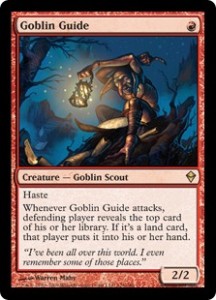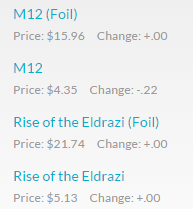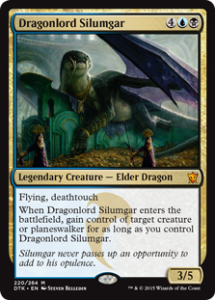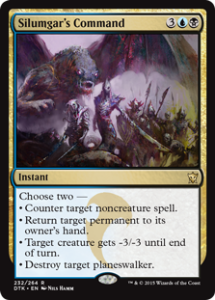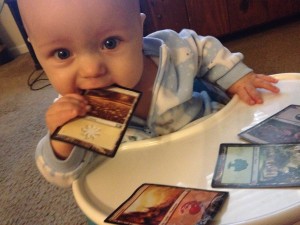I’m pretty excited by Zurgo Bellstriker. My first deck was mono-red, and back in those days, Ironclaw Orcs was considered one of the better red creatures for RDW. Don’t believe me? Check out Jon Finkel’s list for Worlds 1998.
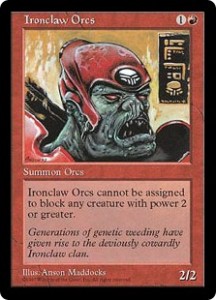
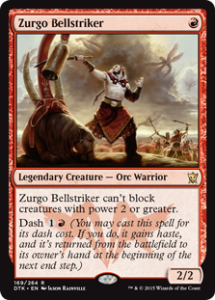
Of course, Ironclaw Orcs wouldn’t be remotely playable these days. Zurgo Bellstriker hits a nice balance between power level and nostalgia, which is a great way to call back to now-obsolete-but-still-classic creatures.
I don’t just like Zurgo Bellstriker for the nostalgia factor, though. I actually think this is a powerful card, and it seems like tournament results so far agree with me. And a 2/2 for one will definitely see play in Modern and Legacy, right?
On second thought, it seems like Modern and Legacy Burn decks have all the one-drops they need. Zurgo obviously isn’t going to see play in Commander, and I’m not about to say that Tiny Leaders will have a huge impact on his price, given that we’re still in the early stages of that format.
So it’s a Standard-only card, right?
You’re forgetting about the most important format: and Zurgo is pretty darn good in Cube.

In Modern, Zurgo would have to be better than one of the two one-drops that Burn wants, and he’s just not. In Cube, though, Zurgo only has to be better than the worst card in the color. The fact that Goblin Guide is still the undisputed king of RDW doesn’t matter. What matters is that Zurgo is a pretty nice upgrade over something like Frenzied Goblin.
What Does This Mean Financially?
Maybe nothing! At the time of this writing, copies of Zurgo are $3.47 for non-foils and $8.61 for foils. Realistically, Cube will not drive the price of non-foils much if at all, meaning that cards only playable in Cube generally don’t have a huge non-foil cost.
Let’s take Gideon Jura as an example. This card was bonkers good in Standard, but at five mana, hasn’t really broken in to Modern. It’s also nowhere near as good in a multiplayer format as in one-on-one play, which is probably why I have never seen it cast in Commander (not to say it’s never happened—I just don’t play a ton of EDH). Given these facts, Gideon is basically at the floor price for a good planeswalker:
But as you can see, the foil prices are about four times those of the non-foil copies, despite the card really having no demand from any established format other than Cube.
I’m not one of them (as I stated pretty emphatically last week), but many Cube owners like to foil out their lists. This means that, much like a Legacy- or Vintage-playable, if a card is good in Cube, the foils of that card are likely to increase sharply compared to their non-foil counterparts. This is especially true because not every player needs a Cube, and those that do have them only need one copy of each card. Foils are significantly rarer than non-foils, and that shows up in Cube demand.
It’s hard to find cards that are only good in Cube. A lot of the non-eternal playables are Commanders staples and vice-versa. Gideon Jura was a pretty good example, but here’s a few others that fit the bill to varying degrees (thanks, in some cases, to being banned in Commander):
Brain Freeze: $1.17 non-foil versus $5.83 foil
Upheaval: $1.99 non-foil versus $17.49 foil
Opposition: $2.76/$3.17 non-foils versus $31.24/$34.89 foils
Braids, Cabal Minion: $3.09 non-foil versus $32.77 foil
Reckless Waif: $0.08 non-foil versus $0.99 foil
You can see that cards deriving demand primarily from Cube (and I think the above apply, but feel free to prove me wrong in the comments) generally have a five- to ten-time multiplier on foil copies.
Granted, cards that are only good in Cube are few and far between, but adding additional demands to a card can only make its price go up. Thus, finding cards playable in Cube plus other formats that have a foil price only about double of the non-foil price may be good opportunities.
Zurgo fits that bill, but don’t buy Zurgo. This card was just released, and unless RDW just completely takes over Standard and stays top-tier, I don’t see it doing anything but going down for some time now. Zurgo foils at $2 compared to $1 non-foils? That’s when it might look like a tempting buy.
Speaking of red one-drops that are good in Cube and basically nowhere else, Firedrinker Satyr non-foils and foils are currently available for $0.79 and $1.81, respectively. I’m more inclined to wait until after rotation, especially since Satyr isn’t exactly a premium one-drop, but this looks like one with potential to at least double up.
Understanding Cube’s Weak Points
If you don’t play Cube, you may not realize what cards Cube players are most aching to see released. If you do know this information, that makes you better prepared to make moves for cards fitting in a particular category.
For example, I’ve talked a lot about red one-drops so far, and for a very good reason. Assuming a cube is supporting aggressive red decks (which I guess means assuming it’s not the Legacy Cube), you simply can’t have enough good one-drops in your list. The same is true for white, as evidenced by the five-times multiplier between Soldier of the Pantheon‘s price points ($0.75/$3.78). In the most recent set, Dragon Hunter might be a foil worth keeping an eye out for, although it’s uncommon and already at $2. Still, it’s new and will likely go down, which is why I’m saying keep an eye on it rather than to go buy out the internet.
Most of the two-color combinations are very deep, and most cubes don’t have a ton of slots for two-color cards. In particular, Boros, Izzet, Selesnya, and Azorius cards are going to be hard-pressed to fight their way into cube lists, since these colors already have so many great options.
The two-color pairs with the least depth are Dimir, Orzhov, and Simic. Unfortunately, we didn’t get any new Orzhov or Simic cards in Dragons of Tarkir, but we did get a couple tasty Dimir dishes:
There are a lot of factors that differ between Dragonlord Silumgar and Sower of Temptation, not the least of which are print run and age, but I just can’t help looking at Sower’s $17.44 price tag as a rare (from the pre-mythic era, yes) versus Silumgar’s $7 price point right now. Again, I’m advocating keeping a close eye here, as if this sees no Standard play (and I don’t expect it to see much, if any) it should drop sharply and present real opportunities. The foils are already over $20, which just goes to show the cube owners are already prioritizing the blue-black card to help shore up a weakness in their lists.
Silumgar’s Command received high praise on the Joy of Cubing podcast, but virtually nobody expects it to be a player in Standard or other competitive formats. Foils are already $7.88 compared to the $1.53 of the non-foils, but I expect at least the non-foils to drop below a dollar. Could this be one of those cards that’s only good in Cube? If so, keep an eye on that foil price to see if you can jump in at a reasonable floor.
There are other things that cube owners are always on the lookout for, especially good mana rocks (meaning they cost two or less, or produce more than one mana) and good equipment (few and far between these days). There’s nothing like that in Dragons, but it’s something to be aware of moving forward.
Cube Makes the World Go ‘Round
At least that’s what enthusiasts of the format want you to think.
In reality, Cube is important to MTG finance because it lets us all play awesome cards that aren’t really good in multiplayer or competitive eternal formats (or are so good they’re banned, as is the case with a few of the cards I listed above). Many of these cards were Standard staples in their days, and are thus important to Magic history, but are in danger of being forgotten because nobody’s playing with them.
Besides people collecting for the sake of collecting, who else is going to want a copy of Eureka? What about Old Man of the Sea? How about just Savannah Lions, which used to be considered overpowered but is now getting close to outclassed in Cube? Once we do reach the point of the Lions no longer being good enough, the card’s only demand will be from collectors and maybe kitchen-table players. That’s kind of sad, right?
Cube doesn’t generally cause huge spikes in non-foils, although it can certainly cause certain foils to get rather expensive. But Cube does keep cards like Upheaval and Opposition relevant, even as they’re banned or outclassed in every other format in which they’re legal. To me, the more relevant cards out there, the easier it is to make money with Magic. And isn’t that why we’re here?
So just like Jason exhorting you to try out Commander, I’m telling you that learning the ins and outs of why Cube is Literally the Best Format Ever™ will help you to better appreciate yet another aspect of Magic finance that can make you money. Happy cubing!

